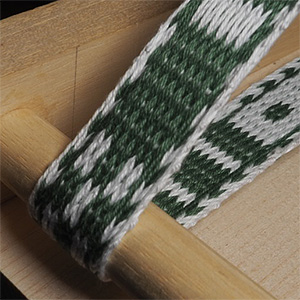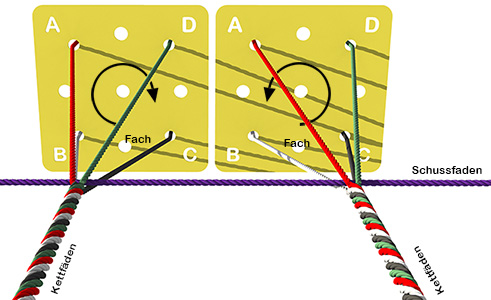Board weaving introduction
Board weaving is, simply put, the twisting of 4 or 6 coloured threads, which are prevented from turning back with a thread passed at 90° to them.
The process again, seen from very close up so to speak:
4 coloured threads, which are led through a small board with 4 holes, are twisted by turning the board around its axis.
At each quarter turn, a thread is added at 90° to secure it. This thread is called the weft thread.
The weft thread is thus laid back and forth twice during a perfect board rotation.
(4 wefts)
Two of the four warp threads are above and two below the weft thread.
We call the space between the upper two and the lower two threads a shed.
Let's look at the whole thing a bit more closely:
.
In front of us, with the flat side turned towards us, is our little board with four holes.
We call these holes A, B, C and D.
From behind come four coloured threads.
Through A a red one, through B a white one, at C comes a grey one and finally through D a green one.
If we turn this board clockwise, the threads wrap around each other, virtually clockwise too.
We call this winding Z-twist because it winds from the bottom left to the top right, as with the letter Z.
If we turn the board anticlockwise the threads turn from bottom right to top left, like the middle stroke of the letter 'S'.
Consequently, this is an S-twist.
For our pattern band, we take ten small boards, so 10 x 4 threads.
With a board measurement of about 8cm, this gives a row of 80cm.
This might be feasible, but it is extremely impractical, as the threads are woven onto a 2cm wide ribbon.
Introduction to board weaving



